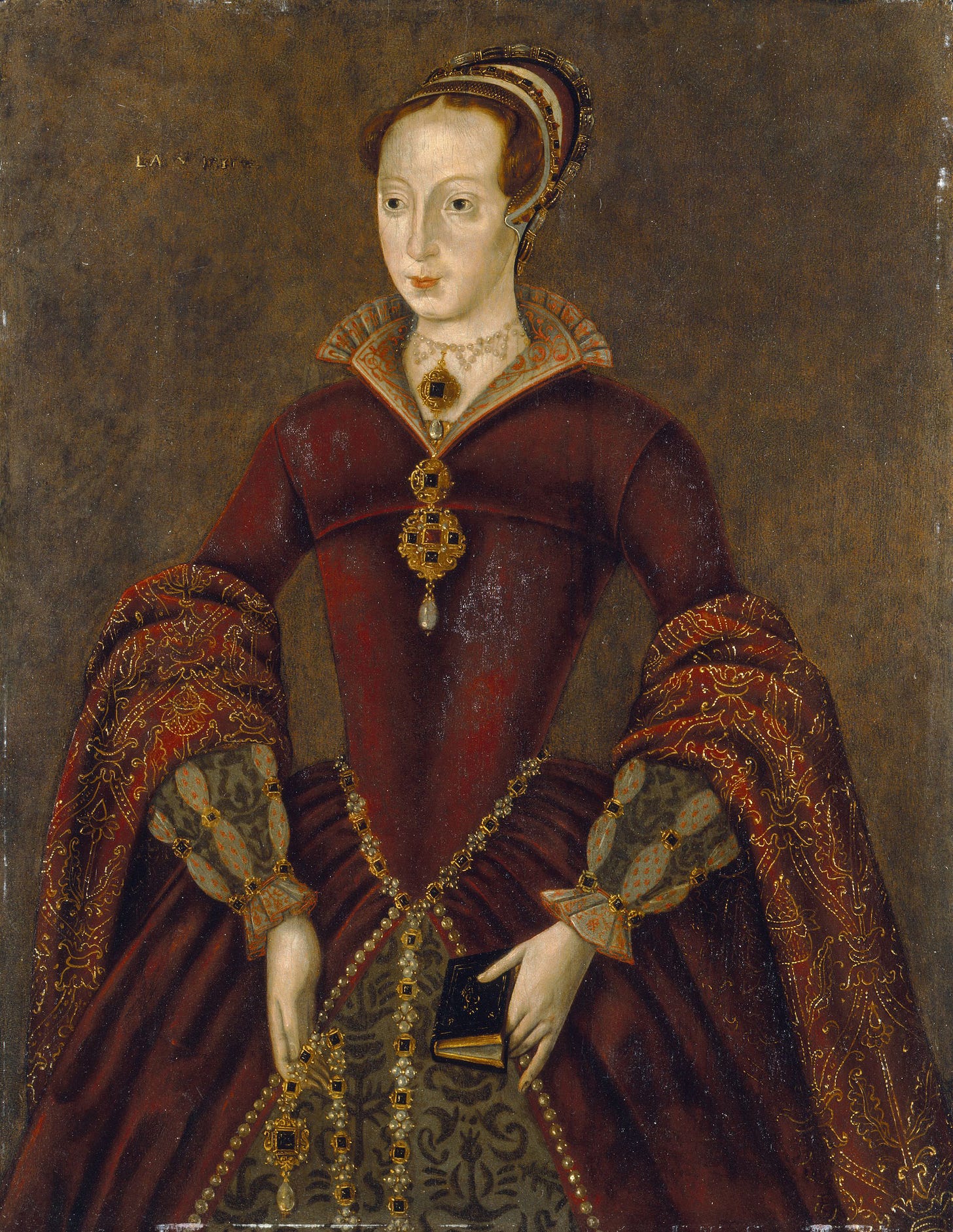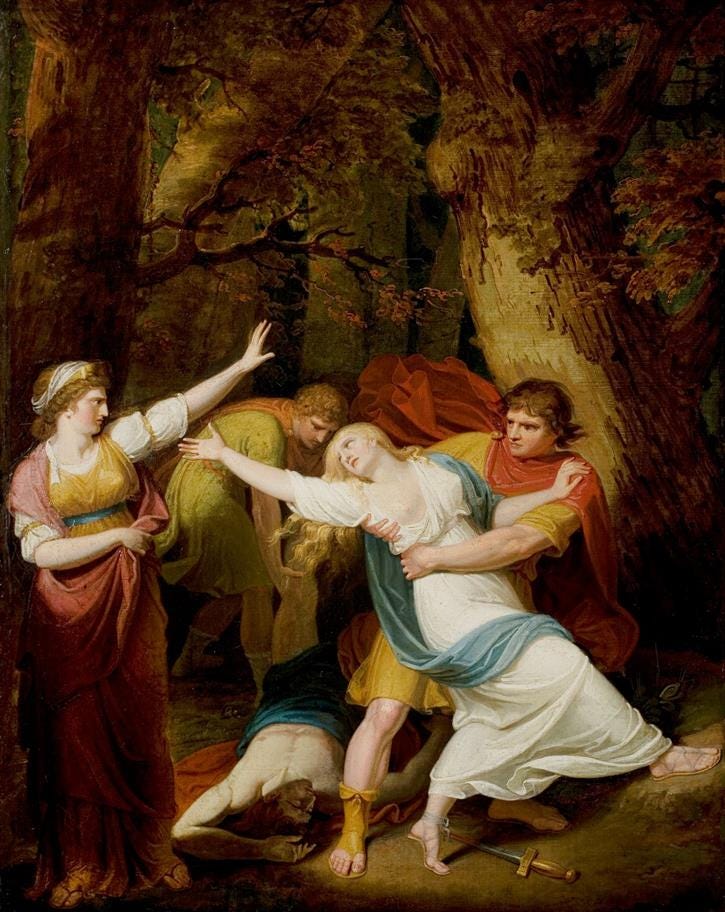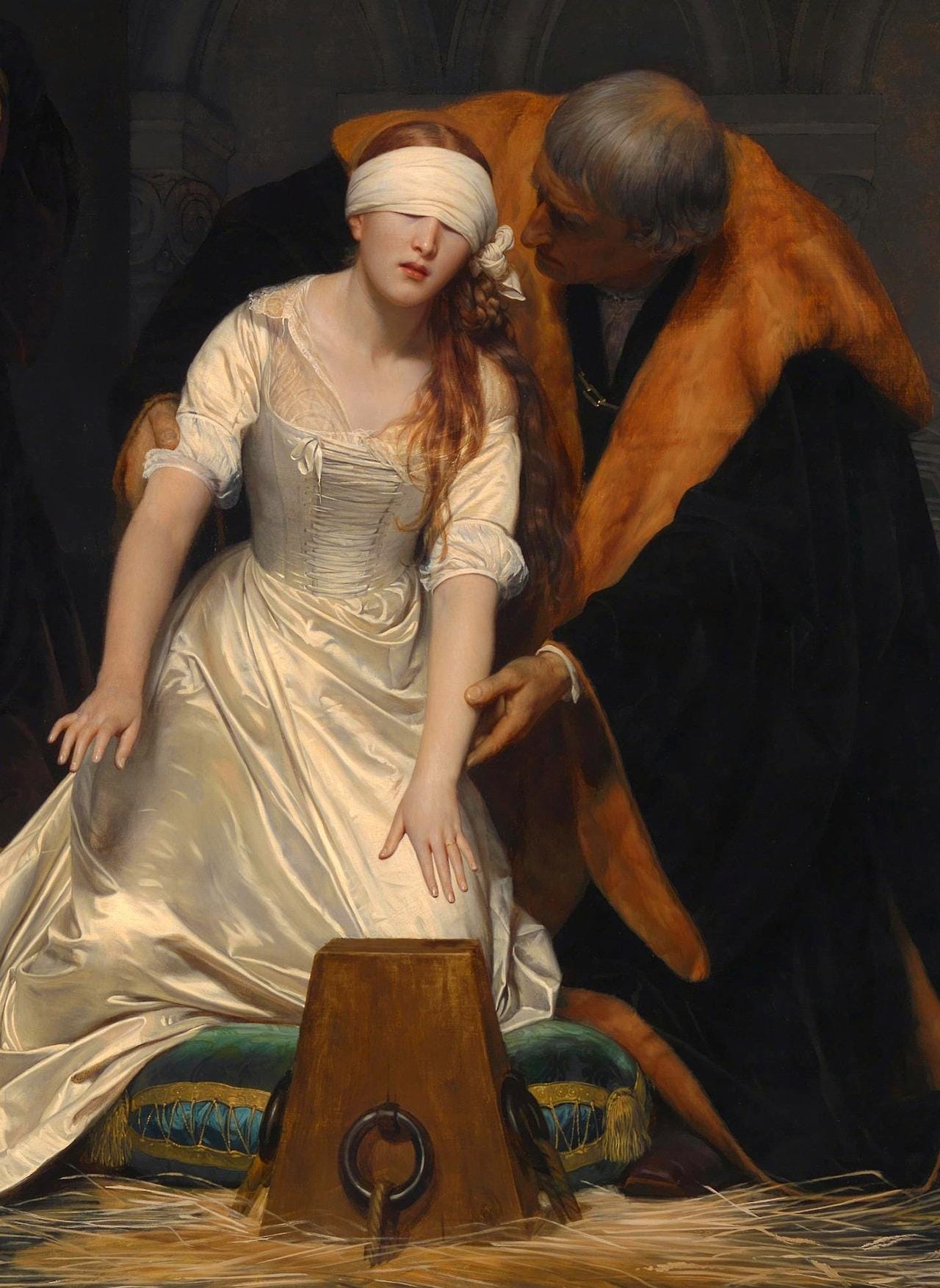“Her sleeves [were] edged with lawn, neatly plaited round the wrists. Not wearing chopines to increase her height, as on the occasion of her State entry into the Tower, the people who had not seen her since were greatly surprised at her diminutive stature,” Richard Patrick Boyle Davey writes in his 1909 biography The Nine Days Queen, Lady Jane Grey & her Times. It’s a supposed eyewitness account by a 16th-century merchant, whose image of Jane is vivid and heart-rending. In this, Jane is a tentatively smiling, vulnerable girl—so young and small that people were shocked at her childlike stature when she was being processed to the Tower.
In short: this Jane, small and doe-eyed, never existed. Davey’s depiction of Jane is heavily fictionalized; he included this faked letter in his biography just for the mere effect of sensationalization. Of course, by doing so, he stripped Jane of all her agency, all the tenacity and braveness she faced her fears with when she was living, but what does it matter? The tale of the young girl, helpless in her white dress, is all too familiar to our ears.
Nonetheless, Jane’s story was already much twisted and fabricated for dramatic effect even before Davey wrote his biography. And it’s not just in Davey’s Jane that we see this trend of a tragic heroine archetype. Our society, it seems, has a strange obsession with hearing young girls and women brutalized at the hands of powerful and cruel men. They are vulnerable, gentle, angelic, blameless, and smiling through the pain. This image has often reflected what was expected of young girls in society throughout history, such as passivity and innocence.
Regardless of whether these myths reflect today’s society, the dangers of propagating this sensationalized narrative are all too real. Tales of female helplessness and purity can so quickly twist into tales of male dominance and power. And these stories are reflected in many pieces of literature throughout history. Shakespeare’s Lavinia (Titus Andronicus) is a close parallel to the fictionalized but popular version of Jane Grey.
In Titus Andronicus, Lavinia is a young woman who is raped and mutilated as revenge for her father’s choices. Although she took no part in her father’s decisions, she is still made the target of cruelty and meets a similar end to Jane Grey, as she is ultimately killed as a result of being raped and no longer ‘having virtue’. Again, a product of her father’s decisions.
The popular version of Jane also depicts a young, virtuous girl who was an innocent victim of the greed and ambition of adults—namely, her father. She is said to have been executed as a result of her father leading Protestant revolts against Mary in Jane’s name, despite her not being involved or aware in any way. This version of Jane is defenseless, an innocent lamb offered up to slaughter. She is a ‘good girl’, feminine and helpless. Moreover, Jane is popularly known to have been abused by her parents and forced to accept the crown despite refusing (weakly) many times, possibly through the use of violence.
The real Lady Jane, documented in other brief accounts and her final letters to Katherine, her sister, was a bit different.
Lady Jane Grey, a short biography:
Lady Jane Grey was born in 1537 as the eldest daughter of the Duke and Duchess of Suffolk. Her family was influential in court, as her mother, Lady Frances, was the daughter of Mary Tudor, Henry VIII's younger sister. This made Jane the cousin of King Edward VI, Mary I, and Elizabeth I.
Jane was intelligent and well-educated, learning Greek, Latin, and Hebrew, as well as French and Italian. On one occasion, Roger Ascham, a classics scholar and tutor to Elizabeth I, visited the Grey household. He was pleasantly surprised at Jane’s precociousness and penchant for learning, and later connected her to other scholars to begin her further studies in theological studies.
When she was ten, Jane was sent to live with Edward VI’s maternal uncle, Thomas Seymour, and his wife, the Dowager Queen and Henry VIII’s widow, Katherine Parr. Jane was very close to Katherine, who oversaw Jane’s education and shaped Jane’s strong Protestant beliefs. However, Katherine died in childbirth shortly after and Jane grieved heavily for her.
Although it was originally planned to marry Jane to King Edward VI, Jane’s parents married her to Lord Guildford Dudley, son of the Duke of Northumberland, who was the most powerful man in England after the King. Edward VI named Jane his successor, as he wanted his heir to be a Protestant. Though reluctant, Jane accepted the crown under pressure from her husband, parents, and the Privy Councillors assembled.
Despite this, the future Mary I had the support of the populace. Within nine days, Jane was overthrown and Mary was proclaimed the rightful queen. At the beginning of Mary’s reign, Lady Jane Grey was sent to the Tower of London and later sentenced to death for high treason in 1553. However, Mary suspended the sentence, considering Lady Jane’s young age. But shortly after, Jane’s father joined a Protestant rebellion and Jane continued to condemn Catholicism as a prisoner in the Tower. Mary’s advisors insisted that Jane was a threat to Mary’s reign, as Jane was the heart of Protestant revolts, the same way Mary represented Catholicism.
Still, Mary wanted to show her young cousin mercy. Lady Jane was told that if she converted to the Catholic faith, she would be spared. But Jane refused, resolute in her faith. Finally, the sentence was carried out.
Jane spent the evening before her execution writing a letter to her sister Katherine, defending the Protestant faith against the Catholic Church:
My good sister, once more again let me entreat thee to learn to die; deny the world, defy the devil, and despise the flesh, and delight yourself only in the Lord: be penitent for your sins, and yet despair not; and desire with St. Paul to be dissolved and to be with Christ, with whom, even in death there is life.
On February 12, 1554, Jane, then sixteen or seventeen, was executed. Jane reportedly asked the executioner to take her blindfold off. He refused, leading her to panic, saying: “What shall I do? Where is it?” After her initial panic, someone guided her hands to the block. Jane is said to have then recited Psalm 51 and said, “Lord, into thy hands I commend my spirit”. These were her last words, which Protestants would later use to spin her into a Protestant martyr.
Another sensationalized piece: The Execution of Lady Jane Grey
The tragic story of Jane Grey is a caricature of female naivety and helplessness. Lady Jane is hyper-idealized and fetishized as a young, innocent girl butchered at the hands of greedy adults and men. The sentiment that her death was akin to a virgin sacrifice is evident in Paul Delaroche’s 1833 painting, The Execution of Lady Jane Grey.
Here, Jane is dressed in all white, including even her blindfold. This, with the dimly lit background and the dark clothes of others, makes her appear to be a bright light soon to be extinguished. Jane’s dress is a direct juxtaposition to the executioner’s red hat and pants. Red evokes the image of blood; the executioner’s attire drives home the brutality of the act about to be done to this young and pure girl.
Jane’s skin is very pale and soft compared to the priest’s. While her ladies-in-waiting are portrayed in natural and animated positions, Jane appears very stiff. She looks more like a doll than a human, helpless as she is moved around by demanding hands. Unable to see and having to rely on the men around her to move, this Jane is the quintessence of female helplessness. The contrast between this depiction and the headstrong, resilient girl who would not give up her beliefs for anything is almost painful. The Jane who spent her last evening writing a letter to her sister Katherine, encouraging her to stand firm in her Protestant faith is buried under the image of this still, powerless girl.
Going back to my prior parallel of Lavinia with Jane: in Shakespeare’s play, Lavinia’s tongue and hands are cut off by her rapists to prevent her from communicating with others about her traumatic experience. This completes her character: the apotheosis of female passivity and helplessness.
Similarly, the Jane depicted in fictionalized accounts and in Paul Delaroche’s portrait, The Execution of Lady Jane Grey, is a passive and vulnerable girl. In this painting especially, Jane—like Lavinia—is stripped of all means of communication and agency. The blindfold also makes it impossible for the viewer to see more of her eyes than slivers. This strips Jane of possibly the most humanizing feature in humans, completing the image of a sacrificial lamb. Most paintings have a somewhat two-way communication as the subject of the painting gazes at the viewer as they look. In this painting, however, Jane is vulnerable to the mass of onlookers without reciprocation.
The men appear as imposing and powerful compared to Jane. Even the priest, who seems to be looking sympathetically at Jane, looms over her. While the painting is crowded in the left and center, the executioner singlehandedly takes up the righthand space, making the painting unbalanced. The focus is on Jane for her white attire and the executioner for his abnormally large figure. The scene looks like it is straight out of a movie. Dynamic and theatrical, the painting reduces Jane to a doll and now a myth.
This painting by Hendrick Scholten, a Dutch painter, also depicts Jane in her last moments before her execution. However, this version of Jane draws a startling contrast with the Jane in Paul Delaroche’s highly dramatized and sensational painting.
Even at first glance, we can quickly sense the slower, unpretentious mood of the painting. Jane is standing rather than kneeling. The absence of a blindfold humanizes her to the viewers. This Jane is closer to the Jane as described in historical documents, who was described as self-possessed and pious, refusing to give up her beliefs in exchange for clemency. Still, we prefer Delaroche’s Lady Jane over Hendrik Jacobus Scholten’s The Last Moments of Lady Jane Grey for its vivid and shocking depiction.
While the tragedy of Jane’s death at sixteen is no doubt true, Delaroche’s portrayal of Jane under the archetype of a young, innocent girl, characterized by her purity and vulnerability to men, is heavily fictionalized. Jane was clever, determined, and strong in her own right. Her death was not the sole result of adult ambition, but her firm religious stance and refusal to convert to Catholicism. Although she was forced to take the throne and become queen, she dealt with her situation on her own terms, a kernel of truth that is often ignored. Even her last words, the recitation of Psalm 51, are often brushed aside for the more poignant cries of a young, scared girl. In Paul Delaroche’s painting, Lady Jane Grey is perpetually frozen as a clichéd tragedy rather than a powerful tale of female agency and resilience.











Such a wonderful and educating read!
really interesting essay. reminds me of Ophelia in Hamlet and how she is more often painted in death than in life. it’s like male artists make the same mistake as Hamlet and Laertes by doting on her corpse more than they ever valued her as a person.